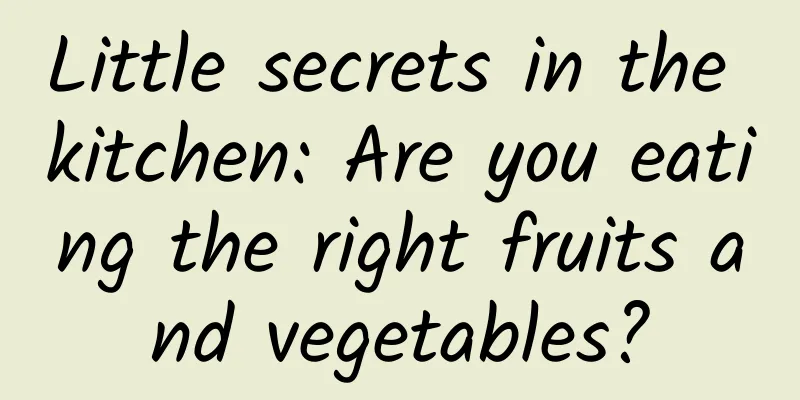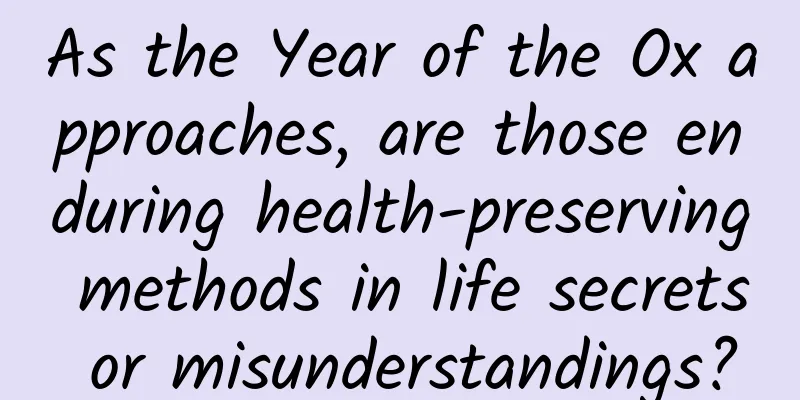Little secrets in the kitchen: Are you eating the right fruits and vegetables?

|
It would be a waste to wash off the "white frost" on these fruits! Some fruits are covered with a layer of white powdery substance on the skin, and many people mistakenly believe that this is pesticide residue on the fruit. In fact, this "white frost" is not pesticide, but wax produced by the skin itself. Its main function is to prevent water evaporation and resist infection by bacteria. Take grapes for example. The main component of the wax on the surface of grapes is a substance called oleanolic acid, which can account for 60%-70% of the total weight of the white frost. In addition, the white frost also contains some alcohols and esters. These substances have one thing in common, that is, they are insoluble in water. Because of this, friends who want to wash off the white frost on grapes will often go crazy (because it is too difficult to wash off!). In fact, you don’t need to wash off the white frost when eating grapes, because oleanolic acid does not harm our health, and it is even helpful for protecting the liver and fighting viruses. In addition, the white frost on the surface of fruits such as blueberries and plums is similar to the white frost on grapes. In addition, the wax on the fruit skin also shows that these fruits are very fresh. Should bananas with small black spots be thrown away? Bananas with small black spots are the most delicious! When buying bananas, many people usually avoid bananas with black spots. In fact, bananas are the most delicious at this time. Because the appearance of small black spots on bananas means that they have reached the peak of maturity. Not only are they soft and sweet, but they are also cheaper at this time. However, it is recommended not to buy too much. It is best to buy and eat them now, and not to store them for a long time, otherwise they will easily rot and deteriorate. In addition, the small black spots on some mangoes are also a sign of their increasing maturity. The black spots are usually caused by fungal infection on the peel and do not affect normal consumption. Is the water chestnut with small black spots spoiled? After cutting the wild rice, you may find a lot of black spots inside. How are these black spots formed? Can we still eat it? In fact, they are related to the growth characteristics of wild rice, because the white and tender wild rice we eat is formed when its originally thin young stems are infected by smut fungi, and then swell and become thicker. In other words, the growth of wild rice is inseparable from smut fungi. In the early stage, smut fungi mainly exist in the form of hyphae. When they grow to a certain extent, they will grow spores, which are the small black spots that appear inside the wild rice. If the wild rice is allowed to grow, its inside will turn black. Smut fungi are not harmful to the human body, so wild rice with black spots can also be eaten, but the taste is rougher than before. Is the vitamin C content in mung bean sprouts related to “height”? Bean sprouts are "living vegetables" formed after beans germinate. Compared with beans before germination, bean sprouts not only change in appearance, but also greatly increase in nutritional value and utilization rate. The most typical thing is that dry beans basically do not contain vitamin C, but bean sprouts are very rich in vitamin C, which can maintain skin elasticity. However, although bean sprouts are rich in vitamin C and B vitamins, the content is unstable. Take mung bean sprouts as an example. When the vitamin C content is high, it can reach more than 100 mg per 500 grams, but only 30 mg when it is low. When mung bean sprouts grow to about 1 cm, the nutritional value is the highest, and the vitamin C content of 500 grams of mung bean sprouts can reach 180 mg. After exceeding 1 cm, the longer they grow, the lower the vitamin C content. When they exceed 3 cm, they only contain 30-40 mg of vitamin C per 500 grams. Fresh mushrooms are more nutritious after "sunbathing" A research report published in the journal "Dermatoendocrinology" pointed out that in addition to being delicious, mushrooms are also an important source of vitamin D. Drying fresh mushrooms (oyster mushrooms, shiitake mushrooms, king oyster mushrooms, etc.) in the sun before eating them can supplement vitamin D in a way that is comparable to vitamin D supplements. Its mechanism is similar to that of human skin. Under the irradiation of ultraviolet rays from the sun, mushrooms can produce vitamin D, and even after being picked, mushrooms can still do this. This study also suggests that the vitamin D content in dried mushrooms that have been air-dried is higher than that in freshly picked mushrooms. Researchers recommend that after buying fresh mushrooms home, open the package and place them in the sun for 1 hour. After the mushrooms are dried, they can be cooked and eaten, and the vitamin D in them is not easily lost. Delicious fruit and vegetable chips are actually a calorie bomb! Potato chips are delicious, but the calories are amazing, so eating some crispy snacks made of vegetables and fruits should be fine, right? Haha, I can only say that you are too naive. First of all, if you want to make fruits and vegetables with a high water content taste "crispy", a big secret is to be willing to use oil. For fried fruit and vegetable chips, vegetable oil is usually the first in the ingredient list. It can also be seen from the nutritional composition table that the fat content is generally 27%-40%, which is comparable to the potato chips we eat. Take apple crisps as an example. The fat content of apples itself is only about 0.2%. After being made into fried apple crisps, the fat content is about 34%, which is 170 times higher. If you eat 100 grams of this "apple crisp", you will unknowingly eat more than 30 grams of fat, and the recommended daily intake of edible oil for each person is no more than 30 grams. In addition to a lot of oil, the ingredient list of fruit and vegetable crisps often contains a lot of sugar and salt. In order to make fruit and vegetable crisps taste better, merchants will add a lot of refined sugars including maltose syrup and maltodextrin, which greatly reduces the nutrition of vegetables that originally have the advantage of being "sugar-free". Not only that, salt is also added to fruit and vegetable crisps for seasoning, making people unable to stop eating. Therefore, when eating fruit and vegetable crisps, you will accidentally eat more extra salt and sugar. In our daily diet, salt and sugar are very easy to exceed the standard, and they are ingredients that need to be controlled in particular. When choosing fruit and vegetable chips, it is best to choose "non-fried" chips with low fat content. The fat content of such products usually does not exceed 5%, which can be seen in the nutritional information table. And from a nutritional point of view, non-fried fruit and vegetable chips are closer to the raw fruits and vegetables. If the fruit and vegetable chips are made by vacuum freeze-drying process, the nutrition is better preserved. However, the taste is slightly inferior to that of fried chips. Is it okay to use juice instead of fruit? From the perspective of nutrient retention, eating fruit directly is better than making juice. First, making juice will increase the contact area between vitamin C, polyphenols and other antioxidant components in the juice and the air, accelerate the oxidation reaction, and thus lose some nutrients. Secondly, Fan Zhihong, an associate professor at the College of Food Science and Nutritional Engineering of China Agricultural University, once conducted a study and found that foods containing dietary fiber can indeed lower blood sugar and blood lipids, but the effect of lowering blood sugar and blood lipids is not only related to the type of fiber, but also to the size of the fiber. When we make juice from whole fruits, the dietary fiber will be broken and reduced, and some will filter out the pomace (dietary fiber), so the effect of lowering blood sugar and blood lipids will be reduced. Of course, no food is without nutrition, and no food is fully nutritious. Each food has its own nutritional characteristics, and so does juice. Juice contains organic acids, vitamin C, soluble dietary fiber, and antioxidant polyphenols, and is also worth drinking. When drinking juice, try to keep the pomace (that is, dietary fiber) and do not filter it out. There is no problem with drinking it in moderation. But one thing to note is that you should not completely replace vegetables and fruits with juice. |
<<: What are the causes of spring allergies?
>>: Beware of this disease that is easily ignored by the elderly - sarcopenia
Recommend
What kind of food should I buy for a barbecue? What should I buy for a barbecue?
In terms of Chinese food, there is a type of food...
Why do I have a little pain in my breast?
As one of the symbols of women, breasts not only ...
Be careful if you are trying to lose weight or keep fit! This kind of food can easily cause poisoning if eaten raw, so be careful!
Konjac (Amorphophallus konjac) is a perennial her...
For the same cataract, why do some people need surgery while others don’t?
Many friends have been to the Aier Eye Hospital a...
How to calculate 28 days of menstruation
In fact, many people do not have a clear understa...
What details should be paid attention to in cesarean section care
Cesarean section is a common obstetric surgery. F...
Introduction to Yoga for Women
Women's conditioning yoga, in fact, is not on...
After the age of 50, how can you stay strong and improve your quality of life?
An old man complained to Huazi that after he turn...
How many days late is considered pregnancy?
Whether menstruation is normal has a great impact...
How to treat endometrial thickening?
Endometrial thickening is a common gynecological ...
What are fish balls made of? How to make fish balls
Fish balls are delicious and you won't get ti...
Detailed explanation of the basic steps for applying light makeup, white-collar workers can learn quickly!
Nowadays, many office workers will put on a littl...
Early symptoms of pregnancy around two weeks
Many female friends do not have any particularly ...
How big is the fetus at 15 weeks
The biparietal diameter of a fetus at 15 weeks of...
How much does a McDonald's gray coconut cost? Is the McDonald's gray coconut delicious? How does it taste?
We all know that McDonald's launches many new...









